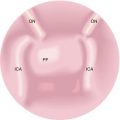John C. Watkinson and David M. Scott-Coombes (eds.)Tips and Tricks in Endocrine Surgery201410.1007/978-1-4471-2146-6_37
© Springer-Verlag London 2014
37. Presentation and Biochemical Assessment of Pituitary Disease
(1)
Department of Endocrinology, Queen Elizabeth Hospital Birmingham, Birmingham, West Midlands, B15 2WB, UK
(2)
University of Birmingham and Queen Elizabeth Hospital Birmingham, University Hospital Birmingham NHS Foundation Trust, Mindelsohn Way, Birmingham, B15 2WB, UK
(3)
Regional Endocrine Laboratory, Clinical Laboratory Services, Queen Elizabeth Hospital Birmingham, Birmingham, West Midlands, B15 2WB, UK
Abstract
Pituitary tumors may present in a number of ways:
Presentation
Pituitary tumors may present in a number of ways:
(a)
Mass effect of the lesion
(b)
Pituitary hormone excess
(c)
Incidental finding following imaging for an unrelated cause (incidentaloma)
Mass Effect of the Lesion
Usually caused by pituitary macroadenomas (tumors >1 cm in diameter)
Visual Loss
Bitemporal hemianopia due to compression of the optic chiasm
Loss of visual acuity due to optic nerve compression
Changes in color perception
Diplopia and/or ptosis due to cranial nerve compression
Hypopituitarism
Thyroid Stimulating Hormone (TSH) Deficiency
Cold intolerance
Fatigue
Weight gain
Constipation
Pale, dry skin
Myalgia
Gonadotrophin Deficiency
Loss of libido
Infertility
Loss of body hair
Amenorrhea, hot flushes, and vaginal dryness in women
Erectile dysfunction in men
Adrenocorticotrophic Hormone (ACTH) Deficiency
Fatigue
Weight loss
Lethargy
Hypotension
Nausea
Growth Hormone (GH) Deficiency
Growth retardation and short stature in children
Lethargy and weight gain in adults
Antidiuretic Hormone (ADH) Deficiency
Diabetes insipidus with polyuria and polydipsia
Stay updated, free articles. Join our Telegram channel

Full access? Get Clinical Tree






